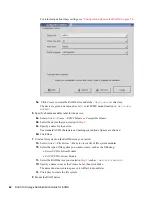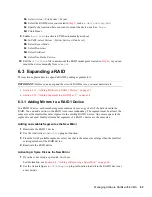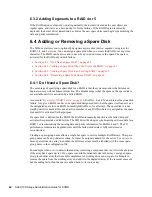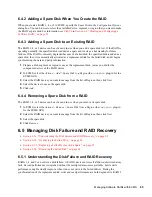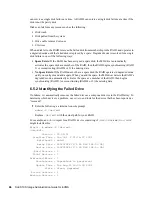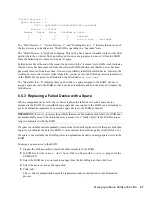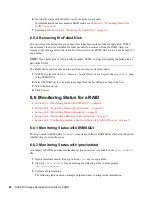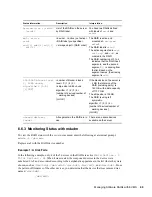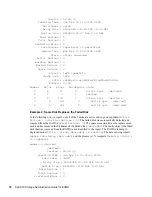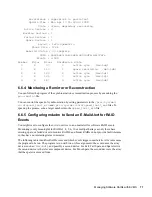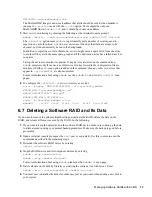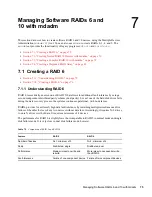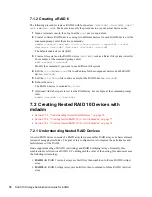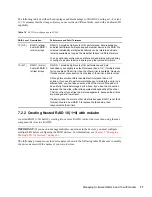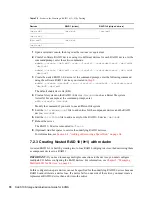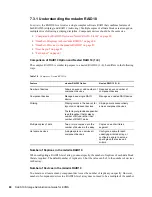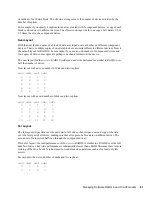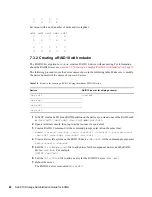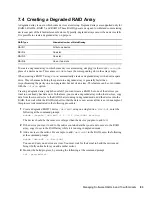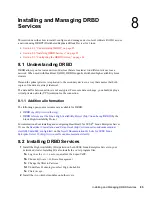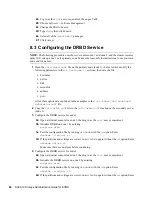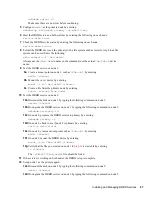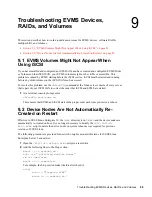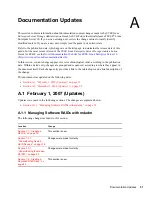
76
SLES 10 Storage Administration Guide for EVMS
no
vd
ocx (
E
NU)
9
Jan
uar
y 2
007
7.1.2 Creating a RAID 6
The following procedure creates a RAID 6 with four devices:
/dev/sda1
,
/dev/sdb1
,
/dev/
sdc1
, and
/dev/sdd1
. Make sure to modify the procedure to use your actual device nodes.
1
Open a terminal console, then log in as the
root
user or equivalent.
2
Create 2 software RAID 0 devices, using two different devices for each RAID 0 device. At the
command prompt, enter these two commands:
mdadm --create /dev/md0 --run --level=raid6 --chunk=128 --raid-
devices=4 /dev/sdb1 /dev/sdc1 /dev/sdc1 /dev/sdd1
The default chunk size is 64 (KB).
3
Create a file system on the RAID 6 device
/dev/md0
, such as a Reiser file system (reiserfs).
For example, at the command prompt, enter
mkfs.reiserfs /dev/md0
Modify the command if you want to use a different file system.
4
Edit the
/etc/mdadm.conf
file to add entries for the component devices and the RAID
device
/dev/md0
.
5
Edit the
/etc/fstab
file to add an entry for the RAID 6 device
/dev/md0
.
6
Reboot the server.
The RAID 6 device is mounted to
/local
.
7
(Optional) Add a hot spare to service the RAID array. For example, at the command prompt
enter:
mdadm /dev/md0 -a /dev/sde1
7.2 Creating Nested RAID 10 Devices with
mdadm
Section 7.2.1, “Understanding Nested RAID Devices,” on page 76
Section 7.2.2, “Creating Nested RAID 10 (1+0) with mdadm,” on page 77
Section 7.2.3, “Creating Nested RAID 10 (0+1) with mdadm,” on page 78
7.2.1 Understanding Nested RAID Devices
A nested RAID device consists of a RAID array that uses another RAID array as its basic element,
instead of using physical disks. The goal of this configuration is to improve the performance and
fault tolerance of the RAID.
Linux supports nesting of RAID 1 (mirroring) and RAID 0 (striping) arrays. Generally, this
combination is referred to as RAID 10. To distinguish the order of the nesting, this document uses
the following terminology:
RAID 1+0:
RAID 1 (mirror) arrays are built first, then combined to form a RAID 0 (stripe)
array.
RAID 0+1:
RAID 0 (stripe) arrays are built first, then combined to form a RAID 1 (mirror)
array.
Содержание LINUX ENTERPRISE SERVER 10 - STORAGE ADMINISTRATION GUIDE FOR EVMS
Страница 4: ...novdocx ENU 9 January 2007 ...
Страница 8: ...8 SLES 10 Storage Administration Guide for EVMS novdocx ENU 9 January 2007 ...
Страница 10: ...10 SLES 10 Storage Administration Guide for EVMS novdocx ENU 9 January 2007 ...
Страница 40: ...40 SLES 10 Storage Administration Guide for EVMS novdocx ENU 9 January 2007 ...
Страница 52: ...52 SLES 10 Storage Administration Guide for EVMS novdocx ENU 9 January 2007 ...
Страница 74: ...74 SLES 10 Storage Administration Guide for EVMS novdocx ENU 9 January 2007 ...
Страница 84: ...84 SLES 10 Storage Administration Guide for EVMS novdocx ENU 9 January 2007 ...

